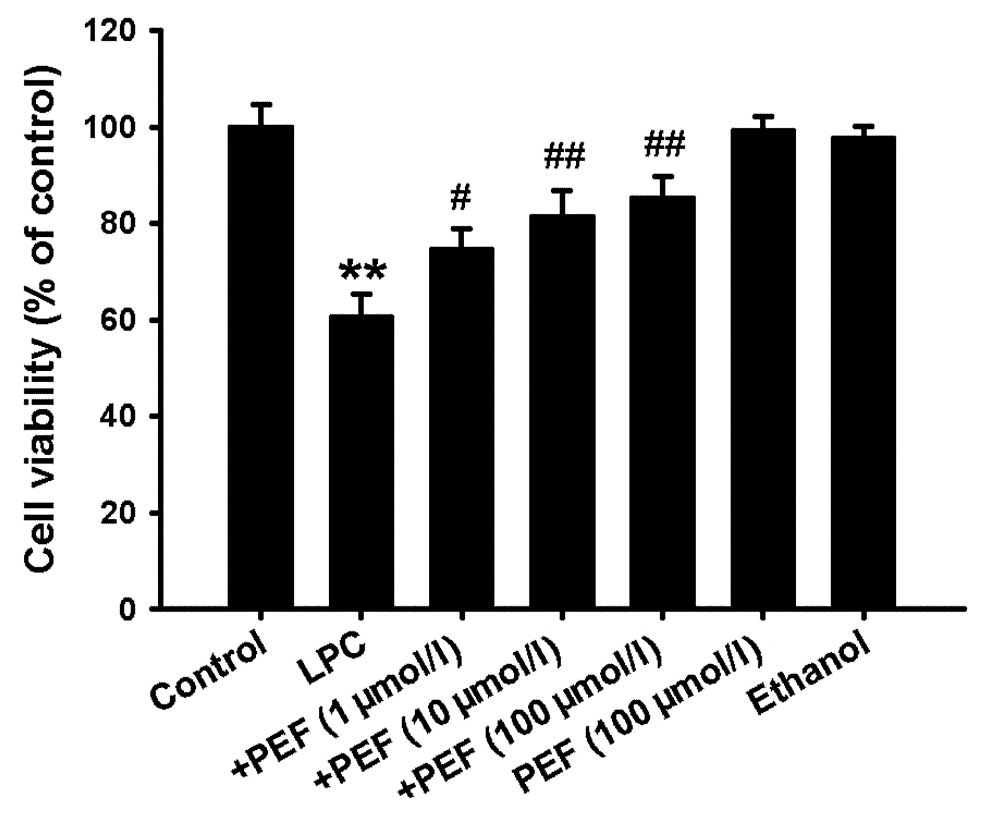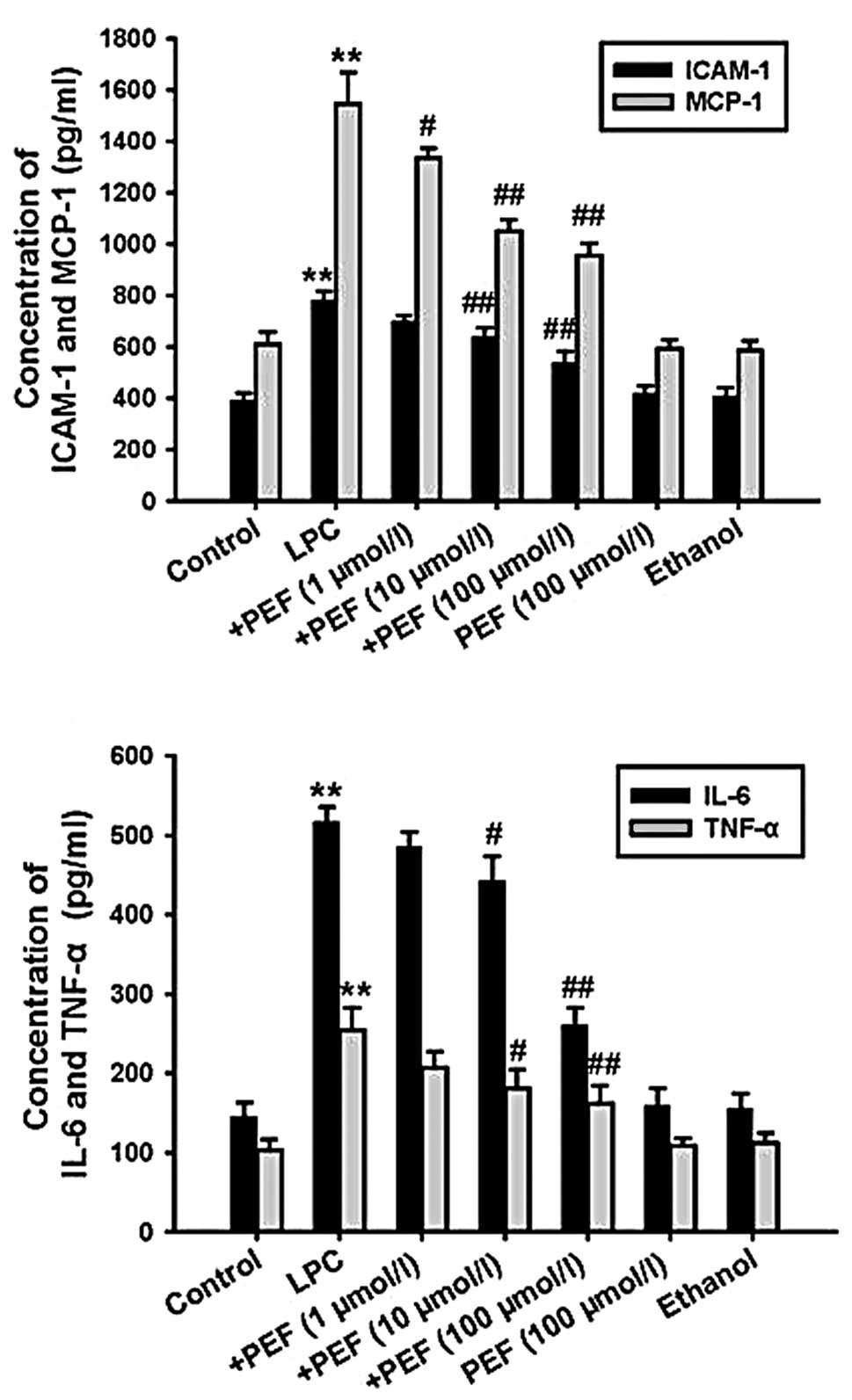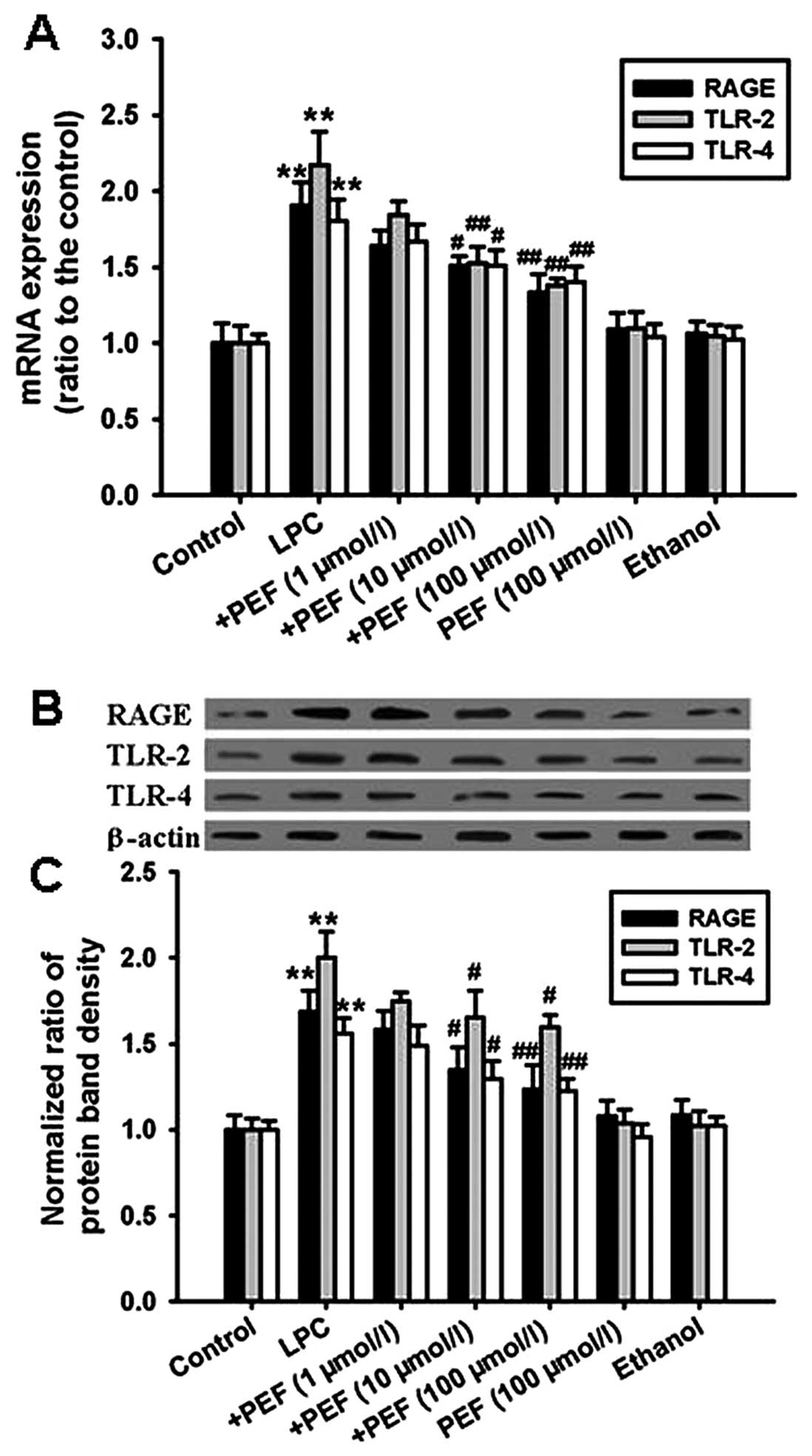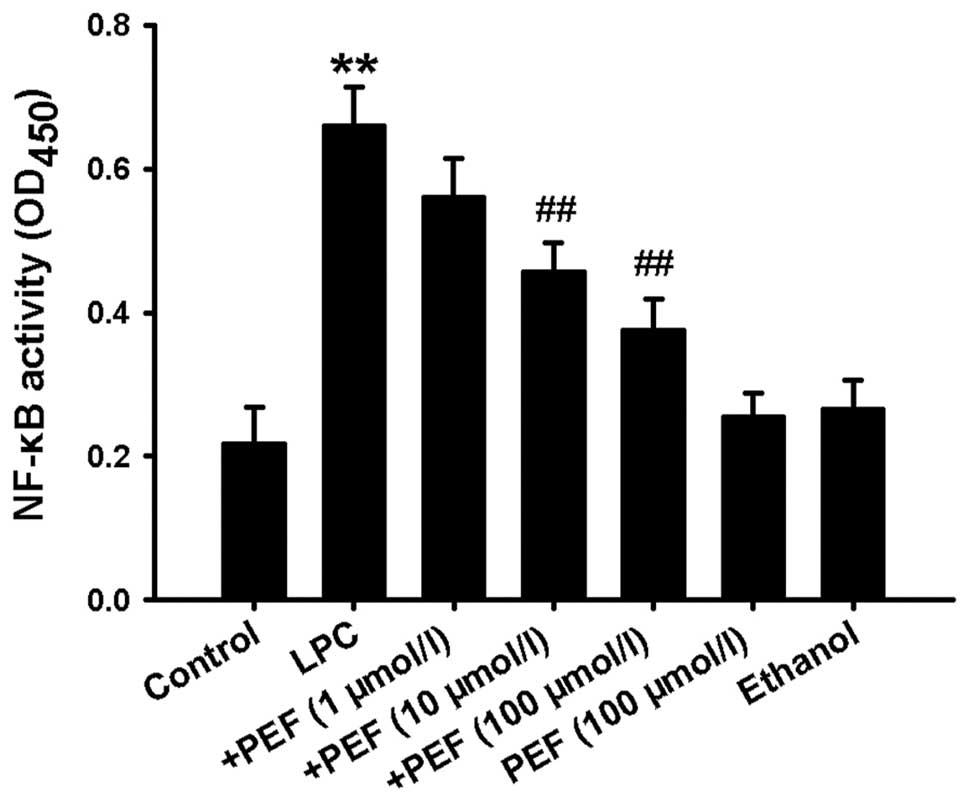|
1.
|
Ross R: Atherosclerosis is an inflammatory
disease. Am Heart J. 138:S419–S420. 1999. View Article : Google Scholar : PubMed/NCBI
|
|
2.
|
Lin R, Liu J, Gan W and Yang G: C-reactive
protein-induced expression of CD40-CD40L and the effect of
lovastatin and fenofibrate on it in human vascular endothelial
cells. Biol Pharm Bull. 27:1537–1543. 2004. View Article : Google Scholar : PubMed/NCBI
|
|
3.
|
Loppnow H, Buerke M, Werdan K and
Rose-John S: Contribution of vascular cell-derived cytokines to
innate and inflammatory pathways in atherogenesis. J Cell Mol Med.
15:484–500. 2011. View Article : Google Scholar : PubMed/NCBI
|
|
4.
|
Sprague AH and Khalil RA: Inflammatory
cytokines in vascular dysfunction and vascular disease. Biochem
Pharmacol. 78:539–552. 2009. View Article : Google Scholar : PubMed/NCBI
|
|
5.
|
Kang H, Yang PY and Rui YC: Adenoviral
gene transfer of viral interleukin-10 protects cerebrovascular
impairment induced by lysophosphatidylcholine. Eur J Pharmacol.
580:175–181. 2008. View Article : Google Scholar : PubMed/NCBI
|
|
6.
|
Matsumoto T, Kobayashi T and Kamata K:
Role of lysophosphatidylcholine (LPC) in atherosclerosis. Curr Med
Chem. 14:3209–3220. 2007. View Article : Google Scholar : PubMed/NCBI
|
|
7.
|
Schaefer CA, Kuhlmann CR, Gast C, et al:
Statins prevent oxidized low-density lipoprotein- and
lysophosphatidylcholine-induced proliferation of human endothelial
cells. Vascul Pharmacol. 41:67–73. 2004. View Article : Google Scholar : PubMed/NCBI
|
|
8.
|
Toshima S, Hasegawa A, Kurabayashi M, et
al: Circulating oxidized low density lipoprotein levels. A
biochemical risk marker for coronary heart disease. Arterioscler
Thromb Vasc Biol. 20:2243–2247. 2000. View Article : Google Scholar : PubMed/NCBI
|
|
9.
|
Mazière C and Mazière JC: Activation of
transcription factors and gene expression by oxidized low-density
lipoprotein. Free Radic Biol Med. 46:127–137. 2009.PubMed/NCBI
|
|
10.
|
Yu X, Xing C, Pan Y, Ma H, Zhang J and Li
W: IGF-1 alleviates ox-LDL-induced inflammation via reducing HMGB1
release in HAECs. Acta Biochim Biophys Sin. 44:746–751. 2012.
View Article : Google Scholar : PubMed/NCBI
|
|
11.
|
Zhang J, Takahashi HK, Liu K, et al:
Anti-high mobility group box-1 monoclonal antibody protects the
blood-brain barrier from ischemia-induced disruption in rats.
Stroke. 42:1420–1428. 2011. View Article : Google Scholar : PubMed/NCBI
|
|
12.
|
Naglova H and Bucova M: HMGB1 and its
physiological and pathological roles. Bratisl Lek Listy.
113:163–171. 2012.PubMed/NCBI
|
|
13.
|
Chen G, Ward MF, Sama AE and Wang H:
Extracellular HMGB1 as a proinflammatory cytokine. J Interferon
Cytokine Res. 24:329–333. 2004. View Article : Google Scholar : PubMed/NCBI
|
|
14.
|
Nadatani Y, Watanabe T, Tanigawa T, et al:
High mobility group box 1 promotes small intestinal damage induced
by nonsteroidal anti-inflammatory drugs through Toll-like receptor
4. Am J Pathol. 181:98–110. 2012. View Article : Google Scholar : PubMed/NCBI
|
|
15.
|
Lee W, Kim TH, Ku SK, Min KJ, Lee HS, Kwon
TK and Bae JS: Barrier protective effects of withaferin A in
HMGB1-induced inflammatory responses in both cellular and animal
models. Toxicol Appl Pharmacol. 262:91–98. 2012. View Article : Google Scholar : PubMed/NCBI
|
|
16.
|
Lee W, Ku SK, Bae JW and Bae JS:
Inhibitory effects of lycopene on HMGB1-mediated pro-inflammatory
responses in both cellular and animal models. Food Chem Toxicol.
50:1826–1833. 2012. View Article : Google Scholar : PubMed/NCBI
|
|
17.
|
Park JS, Svetkauskaite D, He Q, Kim JY,
Strassheim D, Ishizaka A and Abraham E: Involvement of toll-like
receptors 2 and 4 in cellular activation by high mobility group box
1 protein. J Biol Chem. 279:7370–7377. 2004. View Article : Google Scholar : PubMed/NCBI
|
|
18.
|
Luan ZG, Zhang H, Yang PT, Ma XC, Zhang C
and Guo RX: HMGB1 activates nuclear factor-κB signaling by RAGE and
increases the production of TNF-α in human umbilical vein
endothelial cells. Immunobiology. 215:956–962. 2010.
|
|
19.
|
He DY and Dai SM: Anti-inflammatory and
immunomodulatory effects of Paeonia lactiflora pall., a
traditional Chinese herbal medicine. Front Pharmacol.
2:102011.PubMed/NCBI
|
|
20.
|
Tang NY, Liu CH, Hsieh CT and Hsieh CL:
The anti-inflammatory effect of paeoniflorin on cerebral infarction
induced by ischemia-reperfusion injury in Sprague-Dawley rats. Am J
Chin Med. 38:51–64. 2010. View Article : Google Scholar : PubMed/NCBI
|
|
21.
|
Zhou H, Bian D, Jiao X, Wei Z, Zhang H,
Xia Y, He Y and Dai Y: Paeoniflorin protects against
lipopolysaccharide-induced acute lung injury in mice by alleviating
inflammatory cell infiltration and microvascular permeability.
Inflamm Res. 60:981–990. 2011. View Article : Google Scholar
|
|
22.
|
Wu WC, Hu DN, Gao HX, Chen M, Wang D,
Rosen R and McCormick SA: Subtoxic levels hydrogen peroxide-induced
production of interleukin-6 by retinal pigment epithelial cells.
Mol Vis. 16:1864–1873. 2010.PubMed/NCBI
|
|
23.
|
Wang HR, Li JJ, Huang CX and Jiang H:
Fluvastatin inhibits the expression of tumor necrosis factor-a and
activation of nuclear factor-kappaB in human endothelial cells
stimulated by C-reactive protein. Clin Chim Acta. 353:53–60. 2005.
View Article : Google Scholar : PubMed/NCBI
|
|
24.
|
Barish GD, Yu RT, Karunasiri MS, et al:
The Bcl6-SMRT/NCoR cistrome represses inflammation to attenuate
atherosclerosis. Cell Metab. 15:554–562. 2012. View Article : Google Scholar : PubMed/NCBI
|
|
25.
|
Schmitz G and Ruebsaamen K: Metabolism and
atherogenic disease association of lysophosphatidylcholine.
Atherosclerosis. 208:10–18. 2010. View Article : Google Scholar : PubMed/NCBI
|
|
26.
|
Gonçalves I, Edsfeldt A, Ko NY, et al:
Evidence supporting a key role of Lp-PLA2-generated
lysophosphatidylcholine in human atherosclerotic plaque
inflammation. Arterioscler Thromb Vasc Biol. 32:1505–1512.
2012.PubMed/NCBI
|
|
27.
|
Orlova VV, Choi EY, Xie C, et al: A novel
pathway of HMGB1-mediated inflammatory cell recruitment that
requires Mac-1-integrin. EMBO J. 26:1129–1139. 2007. View Article : Google Scholar : PubMed/NCBI
|
|
28.
|
Gao M, Hu Z, Zheng Y, Zeng Y, Shen X,
Zhong D and He F: Peroxisome proliferator-activated receptor γ
agonist troglitazone inhibits high mobility group box 1 expression
in endothelial cells via suppressing transcriptional activity of
nuclear factor κB and activator protein 1. Shock. 36:228–234.
2011.
|
|
29.
|
Kim TH, Ku SK, Lee T and Bae JS: Vascular
barrier protective effects of phlorotannins on HMGB1-mediated
proinflammatory responses in vitro and in vivo. Food Chem Toxicol.
50:2188–2195. 2012. View Article : Google Scholar : PubMed/NCBI
|
|
30.
|
Yang EJ, Lee W, Ku SK, Song KS and Bae JS:
Anti-inflammatory activities of oleanolic acid on HMGB1 activated
HUVECs. Food Chem Toxicol. 50:1288–1294. 2012. View Article : Google Scholar : PubMed/NCBI
|
|
31.
|
Yang HO, Ko WK, Kim JY and Ro HS:
Paeoniflorin: an anti-hyperlipidemic agent from Paeonia
lactiflora. Fitoterapia. 75:45–49. 2004. View Article : Google Scholar : PubMed/NCBI
|
|
32.
|
Koo YK, Kim JM, Koo JY, Kang SS, Bae K,
Kim YS, Chung JH and Yun-Choi HS: Platelet anti-aggregatory and
blood anticoagulant effects of compounds isolated from Paeonia
lactiflora and Paeonia suffruticosa. Pharmazie.
65:624–628. 2010.PubMed/NCBI
|
|
33.
|
Mao QQ, Zhong XM, Qiu FM, Li ZY and Huang
Z: Protective effects of paeoniflorin against
corticosterone-induced neurotoxicity in PC12 cells. Phytother Res.
26:969–973. 2012. View
Article : Google Scholar : PubMed/NCBI
|
|
34.
|
Zhang LL, Wei W, Wang NP, Wang QT, Chen
JY, Chen Y, Wu H and Hu XY: Paeoniflorin suppresses inflammatory
mediator production and regulates G protein-coupled signaling in
fibroblast-like synoviocytes of collagen induced arthritic rats.
Inflamm Res. 57:388–395. 2008. View Article : Google Scholar : PubMed/NCBI
|
|
35.
|
Kim ID and Ha BJ: The effects of
paeoniflorin on LPS-induced liver inflammatory reactions. Arch
Pharm Res. 33:959–966. 2010. View Article : Google Scholar : PubMed/NCBI
|














